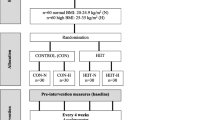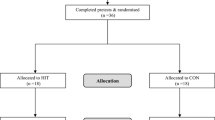Abstract
This study aimed to examine the health effects of fitness training and team-sport training in a pragmatic community health centre set-up for women with lifestyle diseases. The methods included training intensity evaluations and measurements of VO2max, blood pressure, body composition and exercise performance. In all, 40 women in the fitness training group (FG) and 34 women in the team-sport training group (TG) completed a test before they were offered 12–16 weeks of twice-weekly training sessions lasting 60–90 min and after. Mean heart rate during training was not significantly different (P = 0.569) between FG (72.7 ± 4.2%HRmax) and TG (71.4 ± 6.8%HRmax). TG achieved improvements in aerobic fitness of 0.9 ± 2.0 mlO2·kg·min−1 (P = 0.034) and in resting heart rate of 3.7 ± 9.1 bpm (P = 0.026), as well as in sit-to-stand performance (STS: 3.5 ± 3.3 stands · 30 s−1; P = 0.003) and 6‑min walking test performance (6MWT: 53 ± 29 m; P < 0.001), while fat percentage was reduced by 0.6 ± 1.6% (P = 0.038). FG achieved within-group improvements (P < 0.001) in STS performance (3.1 ± 2.8 stands · 30 s−1) and 6MWT performance (41 ± 47 m), with fat percentage reduced by 0.9 ± 1.7% (P = 0.003). Overall, the study revealed no significant between-group differences in training effects. However, there was a between-group difference in training attendance (P = 0.001), with the fitness group having the highest attendance (1.5 ± 0.4 vs. 1.1 ± 0.5 per week). In conclusion, small-sided team-sport training and fitness training conducted in a pragmatic set-up induce similar positive health effects for women with lifestyle diseases. Team-sport training is considered a feasible and worthy alternative to fitness training for sedentary women in community health centres.
Zusammenfassung
Ziel dieser Studie war es, die gesundheitlichen Effekte von Fitnesstraining und Teamsporttraining bei Frauen mit Zivilisationskrankheiten in der pragmatischen Umgebung eines Gemeindegesundheitszentrums zu untersuchen. Beurteilt wurden Trainingsintensität, maximale Sauerstoffaufnahme (VO2max), Blutdruck, Körperzusammensetzung und Übungsleistung. Insgesamt 40 Frauen in der Fitnesstrainingsgruppe (FG) und 34 Frauen in der Teamsporttrainingsgruppe (TG) absolvierten Tests, bevor sie an einem 12- bis 16-wöchigen Trainingsprogramm mit wöchentlich 2 Trainingseinheiten von 60 bis 90 min Dauer teilnahmen und danach. Die mittlere Herzfrequenz während des Trainings unterschied sich zwischen FG (72,7 ± 4,2 % HRmax) und TG (71,4 ± 6,8 % HRmax) nicht signifikant (P = 0,569). Die TG erzielte eine Verbesserung der aeroben Fitness von 0,9 ± 2,0 ml O2·kg−1·min−1 (P = 0,034) und der Ruheherzfrequenz von 3,7 ± 9,1 bpm (P = 0,026) sowie Verbesserungen im Sit-to-stand-Test (STS; 3,5 ± 3,3 Wiederholungen · 30 s−1; P = 0,003) und im 6 min-Gehtest (6MWT; 53 ± 29 m; P < 0,001); ihr Körperfettanteil war um 0,6 ± 1,6 % (P = 0,038) reduziert. Die FG erzielte innerhalb der Gruppe Verbesserungen (P < 0,001) in der STS-Leistung (3,1 ± 2,8 Wiederholungen · 30 s−1) und in der 6MWT-Leistung (41 ± 47 m); ihr Körperfettanteil reduzierte sich um 0,9 ± 1,7 % (P = 0,003). Insgesamt zeigte die Studie zwischen den Gruppen keine signifikanten Unterschiede hinsichtlich der Trainingseffekte. Zwischen den Gruppen bestand jedoch ein Unterschied hinsichtlich der Trainingsteilnahme (P = 0,001); die Fitnessgruppe hatte die höhere Anwesenheitsrate (1,5 ± 0,4 vs. 1,1 ± 0,5 pro Woche) zu verzeichnen. Daraus lässt sich schließen, dass Teamsporttraining und Fitnesstraining in kleinen Gruppen in pragmatischer Umgebung bei Frauen mit Zivilisationskrankheiten ähnlich positive gesundheitliche Effekte haben. Teamsporttraining in Gemeindegesundheitszentren ist für Frauen mit sitzender Lebensweise als praktikable und ebenbürtige Alternative zum Fitnesstraining anzusehen.


Similar content being viewed by others
References
Andersen, L. J., Hansen, P. R., Søgaard, P., Madsen, J. K., Bech, J., & Krustrup, P. (2010). Improvement of systolic and diastolic heart function after physical training in sedentary women. Scand J Med Sci Sports, 20(suppl. 1), 50–57.
Asmussen, E., & Heeboll-Nielsen, K. (1961). Isometric muscle strength of adult men and women. In E. Asmussen, A. Fredsted & E. Ryge (Eds.), Communications from the testing and observation Insitute of the Danish national association for infantile paralysis. Hellerup: Danish National Association for Infantile Paralysis.
Aspenes, S. T., Nilsen, T. I. L., Skaug, E.-A., Bertheussen, G. F., Ellingsen, K., Vatten, L., & Wisløff, U. (2011). Peak oxygen uptake and cardiovascular risk factors in 4631 healthy women and men. Medicine & Science in Sports & Exercise, 43(8), 1465–1473.
Barene, S., Krustrup, P., Jackman, S. R., Brekke, O. L., & Holtermann, A. (2013). Do soccer and Zumba exercise improve fitness and indicators of health among female hospital employees? A 12-week RCT. Scand J Med Sci Sports. https://doi.org/10.1111/sms.12138.
Beato, M., Coratella, G., Schena, F., & Impellizzeri, F. M. (2017). Effects of recreational football performed once a week (1 h per 12 weeks) on cardiovascular risk factors in middle-aged sedentary men. Science and Medicine in Football, 1(2), 171–177.
Connolly, L. J., Scott, S., Mohr, M., Ermidis, G., Julian, R., et al. (2014). Effects of small-volume soccer and vibration training on body composition, aerobic fitness, and muscular PCr kinetics for inactive women aged 20–45. Journal of Sport and Health Science, 3, 284–292.
De Sousa, M. V., Fukui, R., Krustrup, P., et al. (2014). Positive effects of football on fitness, lipid profile, and insulin resistance in Brazilian patients with type 2 diabetes. Scand J Med Sci Sportsm, 24(Suppl. 1), 57–65.
Donges, C. E., & Duffield, R. (2012). Effects of resistance or aerobic exercise training on total and regional body composition in sedentary overweight middle-aged adults. Applied Physiology, Nutrition, and Metabolism, 37(3), 499–509. https://doi.org/10.1139/h2012-006.
Donnelly, J. E., Blair, S. N., Jakicic, J. M., Manore, M. M., Rankin, J. W., & Smith, B. K. (2009). Appropriate physical activity intervention strategies for weight loss and prevention of weight regain for adults. Medicine and Science in Sports and Exercise, 41(2), 459–471.
Fleg, J. L., Morrell, C. H., Bos, A. G., et al. (2005). Accelerated longitudinal decline of aerobic capacity in healthy older adults. Circulation, 112, 674–682.
Haskell, W. L., Lee, I.-M., Pate, R. R., et al. (2007). Physical activity and public health: updated recommendation for adults from the American college of sports medicine and the American heart association. Circulation, 116(9), 1081–1093.
Howley, E. T., Bassett, D. R., & Welch, H. G. (1995). Criteria for maximal oxygen uptake: review and commentary. Medicine & Science in Sports & Exercise, 27(9), 1292–1301. https://doi.org/10.1249/00005768-199509000-00009.
Krustrup, P., Christensen, J. F., Randers, M. B., Pedersen, H., Sundstrup, E., Jakobsen, M. D., Krustrup, B. R., Nielsen, J. J., Suetta, C., Nybo, L., et al. (2010c). Muscle adaptations and performance enhancements of soccer training for untrained men. European Journal of Applied Physiology, 108, 1247–1258.
Krustrup, P., Hansen, P. R., Andersen, L. J., Jakobsen, M. D., Sundstrup, E., Randers, M. B., Christiansen, L., Helge, E. W., Pedersen, M. T., Søgaard, P., Junge, A., Dvorak, J., Aagaard, P., & Bangsbo, J. (2010b). Long-term musculoskeletal and cardiac health effects of recreational football and running for premenopausal women. Scandinavian Journal of Medicine & Science in Sports, 20(Suppl 1), 58–71.
Krustrup, P., Helge, E. W., Hansen, P. R., Aagaard, P., Hagman, M., Randers, M. B., de Sousa, M., & Mohr, M. (2018). Effects of recreational football on women’s fitness and health: adaptations and mechanisms. European Journal of Applied Physiology, 118, 11–32. https://doi.org/10.1007/s00421-017-3733-7.
Krustrup, P., Skoradal, M. B., Randers, M. B., Weihe, P., Uth, J., Mortensen, J., & Mohr, M. (2017). Broad-spectrum health improvements with one year of soccer training in inactive mildly hypertensive middle-aged women. Scand J Med Sci Sports, 27(12), 1893–1901. https://doi.org/10.1111/sms.12829.
Maltais, M. L., Desroches, J., & Dionne, I. J. (2009). Changes in muscle mass and strength after meno-pause. J Musculoskelet Neuronal Interact, 9, 186–197.
Marques, E. A., Mota, J., & Carvalho, J. (2012). Exercise effects on bone mineral density in older adults: a meta-analysis of randomized controlled trials. Age (Dordr), 34, 1493–1515.
Milanović, Z., Pantelić, S., Čović, N., Sporiš, G., Mohr, M., & Krustrup, P. (2019). Broad-spectrum physical fitness benefits of recreational football: a systematic review and metaanalysis. Br J Sports Med, 53(15), 926–939. https://doi.org/10.1136/bjsports-2017-097885.
Mohr, M., Lindenskov, A., Holm, P. M., Nielsen, H. P., Mortensen, J., Weihe, P., & Krustrup, P. (2014). Football training improves cardiovascular health profile in sedentary, premenopausal hypertensive women. Scandinavian Journal of Medicine and Science in Sports, 24, 36–42.
Møller, T. K., Nielsen, T.-T., Andersen, R., Lundager, I., Hansen, H. F., Ottesen, L., Krustrup, P., & Randers, M. B. (2018). Health effects of 12 weeks of team sport training and fitness training in a community health centre for sedentary men with lifestyle diseases. BioMed Research International. https://doi.org/10.1155/2018/1571807.
Nielsen, G., Wikman, J. M., Jensen, C. J., Schmidt, J. F., Gliemann, L., & Andersen, T. R. (2014). Health promotion: The impact of beliefs of health benefits, social relations and enjoyment on exercise continuation. Scand J Med Sci Sports, 24(Suppl. 1), 66–75.
O’Donovan, G., Lee, I.-M., Hamer, M., & Stamatakis, E. (2017). Association of ”weekend warrior” and other leisure time physical activity patterns with risks for all-cause, cardiovascular disease, and cancer mortality. JAMA Intern. Med, 177(3), 335–342.
Ottesen, L., Jeppesen, R. S., & Krustrup, B. R. (2010). The development of social capital through football and running: studying an intervention program for inactive women. Scand J Med Sci Sports, 20(Suppl. 1), 118–131.
Pedersen, B. K., & Saltin, B. (2015). Review—evidence for prescribing exercise as therapy in 26 different chronic diseases. Scandinavian Journal of Medicine & Science in Sports, 25(Suppl.), 1–72.
Pedersen, M. T., Vorup, J., Nistrup, A., Wikman, J. M., Alstrøm, J. M., Melcher, P. S., Pfister, G. U., & Bangsbo, J. (2017). Effect of team sports and resistance training on physical function, quality of life, and motivation in older adults. Scand J Med Sci Sports, 27, 852–864.
Randers, M. B., Nybo, L., Petersen, J., Nielsen, J. J., Christiansen, L., Bendiksen, M., Brito, J., Bangsbo, J., & Krustrup, P. (2010). Activity profile and physiological response to football training for untrained males and females, elderly and youngsters: influence of the number of players. Scand J Med Sci Sports, 20(Suppl. 1), 14–23.
Seidelin, K., Nyberg, M., Piil, P., Jørgensen, N. R., Hellsten, Y., & Bangsbo, J. (2017). Adaptations with intermittent exercise training in post- and premenopausal women. Medicine & Science in sports & exercise, 49(1), 96–105. https://doi.org/10.1249/mss.0000000000001071.
Tella, S. H., & Gallagher, J. C. (2014). Prevention and treatment of postmenopausal osteoporosis. J Steroid Biochem Mol Biol, 142, 155–170.
Thurston, M., & Green, K. (2014). Adherence to exercise in later life: how can exercise on prescription programmes be made more effective? Health Promotion International, 19(3), 379–387. https://doi.org/10.1093/heapro/dah311.
Weston, K. S., Wisløff, U., & Coombes, J. S. (2014). High-intensity interval training in patients with lifestyle-induced cardiometabolic disease: a systematic review and meta-analysis. Br J Sports Med, 48, 1227–1234.
Wiklund, P., Toss, F., Weinehall, L., Hallmans, G., Franks, P. W., Nordstrom, A., & Nordstrom, P. (2008). Abdominal and gynoid fat mass are associated with cardiovascular risk factors in men and women. Journal of Clinical Endocrinology and Metabolism, 93(11), 4360–4366. https://doi.org/10.1210/jc.2008-0804.
Author information
Authors and Affiliations
Corresponding author
Ethics declarations
Conflict of interest
T.K. Møller, T.-T. Nielsen, I. Lundager, R. Andersen, P. Krustrup and M.B. Randers declare that they have no competing interests.
For this article no studies with human participants or animals were performed by any of the authors. All studies performed were in accordance with the ethical standards indicated in each case.
Rights and permissions
About this article
Cite this article
Møller, T.K., Nielsen, TT., Lundager, I. et al. Team-sport training as a worthy alternative to fitness training for sedentary women with lifestyle diseases in a community health centre. Ger J Exerc Sport Res 50, 136–145 (2020). https://doi.org/10.1007/s12662-019-00629-7
Received:
Accepted:
Published:
Issue Date:
DOI: https://doi.org/10.1007/s12662-019-00629-7




